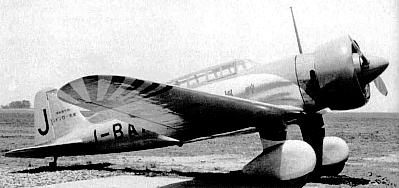
| Caption | Ki-15 aircraft 'Kamikaze' at rest, Japan, circa 1930s; this aircraft was owned by the Asahi Shimbun newspaper group ww2dbase | ||||
| Photographer | Unknown | ||||
| Source | ww2dbaseSan Diego Air and Space Museum via Wikimedia Commons | ||||
| Link to Source | Link | ||||
| Identification Code | 01_00085875 | ||||
| More on... |
| ||||
| Photo Size | 399 x 188 pixels | ||||
| Photos at Same Place | Japan | ||||
| Added By | C. Peter Chen | ||||
| Licensing | This work originating in Japan is in the public domain. According to Article 23 of the 1899 Copyright Act of Japan and Article 2 of Supplemental Provisions of Copyright Act of 1970, a work is in the public domain if it was created or published before 1 Jan 1957. Please contact us regarding any inaccuracies with the above information. Thank you. |
Please consider supporting us on Patreon. Even $1 per month will go a long way! Thank you. Please help us spread the word: Stay updated with WW2DB: |
Visitor Submitted Comments
2.  Bill says:
Bill says:
24 Sep 2016 02:17:33 PM
CIVIL BABS:
File photograph shows the Mitsubishi Ki-15 "Babs" could be civil registered J-BAAO Amakaze or Heavenly Wind, or it could be J-BAAL Asakaze Morning Breeze, were owned and operated by the Japanese newspaper Asahi Shimbum.
In March 1937 another Babs was registered J-BAAL named Kamikaze or Divine Wind, and delivered to the same Japanese newspaper.
Other civil operators also flew the Babs.
IMPERIAL SERVICE:
Both the Imperial Navy and Army operated the Babs. The early model Ki-15-1 and the Ki-15-II, or Army Type 97 was an improved model and flew in China.
The Navy operated the Ki-15-II as the Navy Type 98 Reconnaissance Plane Model 1. The Ki-15 was later withdrawn from front-line service and used as trainers, target tug or other duties.
The survivors were expended in Kamikaze attacks.
CHI-COM BABS:
Communist Chinese (PLAAF)captured a few abandoned Ki-15 Babs, and used them until retired in 1951.
24 Sep 2016 02:17:33 PM
CIVIL BABS:
File photograph shows the Mitsubishi Ki-15 "Babs" could be civil registered J-BAAO Amakaze or Heavenly Wind, or it could be J-BAAL Asakaze Morning Breeze, were owned and operated by the Japanese newspaper Asahi Shimbum.
In March 1937 another Babs was registered J-BAAL named Kamikaze or Divine Wind, and delivered to the same Japanese newspaper.
Other civil operators also flew the Babs.
IMPERIAL SERVICE:
Both the Imperial Navy and Army operated the Babs. The early model Ki-15-1 and the Ki-15-II, or Army Type 97 was an improved model and flew in China.
The Navy operated the Ki-15-II as the Navy Type 98 Reconnaissance Plane Model 1. The Ki-15 was later withdrawn from front-line service and used as trainers, target tug or other duties.
The survivors were expended in Kamikaze attacks.
CHI-COM BABS:
Communist Chinese (PLAAF)captured a few abandoned Ki-15 Babs, and used them until retired in 1951.
All visitor submitted comments are opinions of those making the submissions and do not reflect views of WW2DB.
Search WW2DB
News
- » US Women's Army Corps "Six Triple Eight" Awarded with Congressional Gold Medal (30 Apr 2025)
- » Wreck of Soviet Submarine M-49 Found (10 Apr 2025)
- » Japanese Emperor Visited Iwoto (Iwo Jima) (8 Apr 2025)
- » Race, Holocaust, and African-American WW2 Histories Removed from the US Naval Academy Library (7 Apr 2025)
- » US Government Plans to Purge WW2 Information (17 Mar 2025)
- » See all news
Current Site Statistics
- » 1,167 biographies
- » 337 events
- » 44,617 timeline entries
- » 1,244 ships
- » 350 aircraft models
- » 207 vehicle models
- » 376 weapon models
- » 123 historical documents
- » 261 facilities
- » 470 book reviews
- » 28,514 photos
- » 365 maps
Famous WW2 Quote
"Among the men who fought on Iwo Jima, uncommon valor was a common virtue."Fleet Admiral Chester W. Nimitz, 16 Mar 1945
Support Us
Please consider supporting us on Patreon. Even $1 a month will go a long way. Thank you!
Or, please support us by purchasing some WW2DB merchandise at TeeSpring, Thank you!
20 Oct 2011 10:03:20 PM
Civil J-BAAI aircraft made a record breaking flight in April 1937 flying from Japan to England and return in 51 hours & 17 minutes. Aircraft was named Kamikaze, the flight was
sponsored by the Japanese newspaper Asahi Shimbum.
Aircraft was in natural mental w/blue trim
rising sun flag on wing tips. The Allies code named the Ki-15 "Babs" and was used by both the IJAAF and the IJNAF about 489 were built and served in China.
Later on J-BAAI was put on display, and was destroyed during a B-29 raid most of the surviving Babs were used in Kamikaze attacks
a few survived in Japan after the war, but were among the thousands of combat aircraft destroyed by the Allies.
The Communist Chinese captured different types of Japanese aircraft at the end of WWII
a few of them, were "Babs", and used by the PLAAF the last two were retired in 1951.